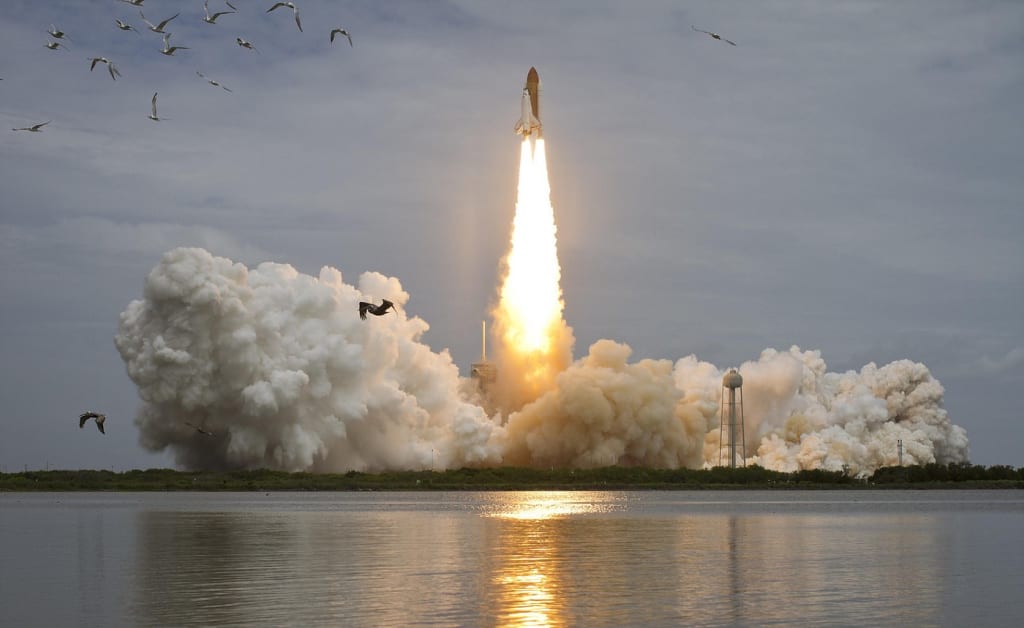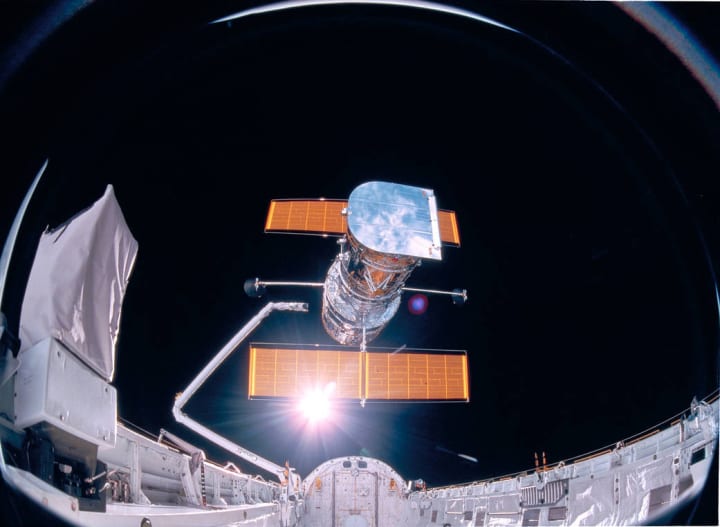Space Shuttle: Final Flight of a Legend
What’s it really like to watch a space shuttle blast off? Even for someone who’s seen hours of footage, it’s literally breathtaking.

IF HUMANITY HAS a beachhead to the stars, this is it: Cape Canaveral. This sandy promontory, jutting out into the Atlantic from a barrier island on the midway point of Florida’s eastern coast, is the site of most of the manned space launches in human history.
Inhabited for more than 12,000 years, and the scene of some of the first encounters between Europeans and Native Americans, it’s often hot and humid, a lowland speckled with marshy lagoons in every direction. Often sunny year-round, it’s also prone to sudden thunderstorms and lightning.
To the north is the Canaveral National Seashore, a national park of pristine beaches and sand dunes that are sanctuary to an abundance of wildlife, from dolphins and manatees to giant sea turtles. It’s a spawning ground for saltwater fish and alligators to swim the rivers and lagoons. It is from this sub-tropical setting that more than 880 people have been lofted into the cold of space. Of those, 833 flew on shuttles.
As long as I could remember, I’ve wanted to come here to see a manned launch from this iconic peninsula. And ever since staying up as a child to watch live pictures on TV of the first space shuttle, Columbia, heave into the sky in April 1981, I’ve wanted — most of all — to see a shuttle launch.
So here I was, on February 24, 2011 — almost 30 years later — preparing to watch the bold, and at times tragic, era of the shuttle draw to a close. The last three remaining orbiters were being retired, and I was coming to see the pride of the fleet: the farewell flight of Discovery, the most travelled and successful of them all.
Discovery was the third shuttle into space, making her maiden voyage in August 1984 — when Ronald Reagan was in the White House, sprinter Carl Lewis had just won four gold medals at the Los Angeles Olympics, apartheid reigned in South Africa and Prince’s Purple Rain was top of the charts.
The actual spacecraft is even older: construction began in August 1979, based on designs proposed a decade earlier. In fact, the whole fleet’s tailor-made onboard avionics computer had 424 kilobytes of magnetic core memory, could process 400,000 instructions per second, had no hard drive, and loaded software from magnetic tape. I’m not kidding. Upgrades in 1990 boosted memory capacity to about 1 megabyte and processor speed to 1.2 million instructions per second.

Considering how often the space shuttle is billed as the most complex vehicle ever built, and its decades-long poster child status for everything futuristic, it’s amazing just how much of a technological relic it is. My iPhone has more memory than the avionics!
But it was the first civilian craft to use a computerised fly-by-wire digital flight control system, with no mechanical or hydraulic links between the pilot’s joystick and the control surfaces or thrusters — the kind we take for granted on modern airplanes. It did not burn out its heat shield on re-entry, and it was the first truly reusable spacecraft.
SINCE ITS MAIDEN flight, Discovery has completed 39 missions, making it the most successful in NASA’s fleet. It benefited from lessons learned in the construction and testing of its sister craft, which is why it weighs some 3,000kg less than the first shuttle, Columbia.
Unofficially, it’s considered ‘the lucky shuttle’: after the disasters that destroyed Challenger at take-off in 1986 and Columbia on re-entry in 2003 (its two sisters from the original fleet of three), Discovery was twice chosen to restart the shuttle program.
And she has indeed had a colourful run: launching the Hubble Space Telescope, flying the first female shuttle pilot, Eileen Collins (who also became the first female shuttle commander, also aboard Discovery). It was the first — and the last — shuttle to dock with Mir, Russia’s space station, twice repaired Hubble, and was first shuttle to dock with the International Space Station. It flew the highest altitude, and carried the oldest human into space: John Glenn, who was 77 and a U.S. Senator at the time and who had made his name as the first American to orbit the Earth in 1962.
“It’s just amazing what this vehicle can do,” astronaut Eric Boe, the pilot for Discovery’s final flight, told a news conference before the farewell flight. “It can launch like a rocket, go into orbit, change into a spacecraft and then land as a hypersonic airplane. What’s amazing is just how well she sails. It’s an honour and privilege for all of us to get the chance to fly on her final voyage.”
THE DRIVE to the launch site is a collage of multi-lane highways and abundant elephant grass interspersed with rivers and lagoons and, of course, bridges and causeways. It’s not hard to believe that there are almost 7,800 lakes and 19,000 km of waterways in Florida.
More surprising is the unending banality of crass Americana: multi-coloured signs atop tall towers are everywhere, advertising Denny’s, Jack in the Box, Burger King, TGI Friday’s, U-Haul — along with a plethora of makeshift signs hollering daily specials in large magnetic letters.
I’d arrived the night before in Orlando, the nearest international airport, and driven to my motel in Titusville, a sizeable town just across the Indian River from the Kennedy Space Centre. Having breakfast at a diner that morning, I watched the cable news channels excitedly discussing the last flight of Discovery, with a live cross to reporters at Cape Canaveral, in between weather forecasts and live traffic updates.

Although I was only a short drive away, I hadn’t fully grasped the effect that 40,000 people — who had descended on the region, known as the Space Coast, to see this historic last hurrah — could have on traffic. I was no sooner on the road again when I was immediately caught in a massive traffic jam that stretched across the causeway and into the outskirts of Titusville. And this was almost seven hours before the scheduled launch. On the radio, I heard that at 10.30 am, the last parking spots in the premier viewing areas around the cape had already been snapped up.
More than six weeks earlier, I’d applied for a press pass to see the take-off from the Launch Complex 39 Press Site, where journalists and camera crews have been covering manned flights since Apollo 8 in 1968. But getting there required peeling back four layers of security, and validating my documentation at various buildings before I could pick up my site access and press passes. With all three approaches across the river clogged with slow-moving cars, it took some time — and patience.
With my passes finally in hand hours later, I barrelled down the road toward the Vehicle Assembly Building, reputedly the fourth largest building in the world by volume: 160 metres high and enclosing 3.7 million cubic metres. Originally built to allow the vertical assembly of the Saturn V rocket that took men to the Moon, it’s since been where the shuttle orbiter — the ‘spaceplane’ component of the space shuttle— is mated with the massive orange-coloured external fuel tank and the two solid rocket boosters that power the monster into the sky.
And a monster it is: at launch, the shuttle orbiter, its external tank, two solid rocket boosters and all the fuel they carry have a total weight of 1,964 tonnes, or 4.4 million U.S. pounds. That’s not including the payload, which is usually around 29 tonnes.
The whole seemingly impossible assembly sits atop a mobile launch platform that is moved slowly to the launch pad 5.6 km away on a Crawler-Transporter: gigantic self-powered land vehicles that can move 7,900 tonnes at a top speed of 1.6 kilometres an hour. Built for US$14 million in the 1960s, there are two of them: each have two control cabins at either end and require a team of nearly 30 engineers, technicians and drivers to operate the vehicle on its six-hour journey.

LAUNCH PAD 39A is where shuttles fly from, part of a launch complex built for the Apollo program. Space X now leases it to launch its Falcon 9 and Falcon Heavy rockets. Its sister, 39B, was deactivated in 2007 — with Discovery the last to use it — and has since been modified to accommodate NASA’s new Space Launch System, a shuttle-derived heavy-lift expendable launch vehicle for deep space exploration, such as the planned Orion program of crewed missions to the Moon and Mars.
By the time I reached the press site, engineers had begun loading the shuttle’s external tank with about 2 million litres of cryogenic propellants. The orbiter’s onboard fuel cells, inertial instruments and communications had been activated. Almost 4.8 km to the northeast, I could see the orange external tank and just make out the white livery of Discovery. The beast was awakening.
Soon, the six astronauts would begin making their way to the pad. I took a vantage point near the iconic countdown clock, which is not just big — it’s mammoth. A little worse for wear, it uses large, old-school incandescent light bulbs to shape its numbers. Behind it, there’s a long series of lakes, coves and creeks between the elevated mound where media facilities are located, and the launch pad. More than 200 people were already on the site, and the foreshore was festooned with camera tripods.
The News Centre, as the area is known, has several buildings: a 100-seat auditorium for press conferences, 15 site support offices, common workspace for journalists and two libraries. Major outlets such as CBS, NBC, CNN and Reuters had their own prefab shacks. The main press room has six large television screens with direct feeds from various sites: the gantry leading into the orbiter, weather and radar maps, and multiple angles of the launch pad.

In the hours that followed, the astronauts entered the orbiter in their bright orange flight suits and strapped in, their helmets by their sides, and began a long list of verbal checks with Launch Control at the Kennedy Space Centre and Mission Control at the Johnson Space Centre in Houston. Technicians in white overalls, baseball caps and head-mounted radios closed the hatch, checked seals for leaks and went through seemingly hundreds of detailed crosschecks.
DISCOVERY WAS NAMED after two historic vessels of the past: one used by 17th century English navigator Henry Hudson to explore Canada’s Hudson Bay and search for a northwest passage from the Atlantic to India; and one by British explorer James Cook in the 1770s in voyages in the South Pacific, leading to the discovery of the Hawaiian Islands.
“We’re wrapping up the space shuttle program,” astronaut Steve Lindsey, commander of Discovery’s last mission — known as STS-133 — told reporters before take-off. “Besides the excitement of completing the International Space Station and all the things we do, I hope people get a sense of the history of what the shuttle is and what we’ve done and what’s ending. Because they’ll probably never see anything like it flying again.”
And Cape Canaveral has been where all of the journeys began. Since 1961, there have been 165 manned launches here — initially from the nearby Cape Canaveral Air Force Station where the pioneering Mercury and Gemini capsules were lofted into the sky, to the Kennedy Space Centre, built for the Apollo missions. And while ‘the Cape’, as it is dubbed, has been busy since the shuttles were retired with the last flight of Atlantis in July 2011, none have been manned launches.
Since the first shuttle lit up the skies of this sandy promontory in 1981, space shuttles have been the workhorse of human spaceflight. And the most diligent of them has been Discovery, which in 39 missions had spent a cumulative 365 days in space and travelled more than 238 million kilometres orbiting the planet — clocking more missions and more time in space than any other spacecraft to date.
TAKE-OFF WAS SCHEDULED for 4.50pm. But with nine minutes to launch, the clock suddenly froze. The Air Force’s range safety computer — which monitors data from sensors dotted along the coastline — indicated a problem, and put the launch in doubt.
Discovery had a razor-thin three-minute launch window before the attempt would have to be abandoned until the following day, and tension mounted as NASA engineers scrambled to determine the cause. Taking a gamble, they restarted the clock in the hope the Air Force would uncover a false alarm and the launch could proceed. But as no word came, the countdown was again stopped at the T-minus five-minute mark. There it held.
Finally, with time running out, NASA engineers received a call saying the glitch was resolved, and resumed the countdown. At exactly 4.53:24 pm — with just three seconds to spare — Discovery blasted off.
When the engines ignited, there was a blinding flash and the whole structure began edging upwards. At first it seemed to gently hover above the launch pad. This was an illusion; it was actually rapidly accelerating, and within a split second, was punching through the air, riding an eye-searing waterfall of white-hot flame as it tore into the clear blue sky.

I’d waited for decades to see it, and had watched countless shuttle launches on television. And still, my mind found it hard to accept what I was seeing. A building 19 storeys high was rising effortlessly into the air, trailed by billowing clouds of superheated steam that raced away in all directions. The plume of flame spewing from the solid rocket boosters was incredibly bright — almost like looking at the Sun. Nothing had prepared me for that.
And the sound. It’s hard to describe: a deep, sonorous, rumbling growl so resonant it reaches into the pit of your stomach, while the skies echo with a stream of thunderous pops and bangs that quickly overpowers the cheering, whooping and rapid-fire camera shutters going off around you. There is a moment — 50 or so seconds in — when the sound is so overwhelming, seemingly pushing on top of you, that silence descends on the crowd.
My pulse was racing, and I found myself watching open-mouthed. It did not close again until the shuttle had, two minutes into the flight, ditched its twin solid rocket boosters 48.7 km above us.
Undulating clouds of steam marked its curling trajectory from the ground into an impossibly high point in the heavens, and the orbiter — its engines now burning fuel from the attached external tank — was just a tiny but brilliant white speck in the deep blue sky that, eventually, vanished. My senses told me something very immense and very powerful had roared to sudden angry life nearby, leaped into the sky in a cacophony of thunderclaps, and all I could do was stare after it, transfixed.

It had been a remarkable show. Discovery was on its way, and its engines would continue firing for another six minutes before the external tank was drained and fell away, to burn up on re-entry. Discovery would loop the Earth several times over the next two days, working its way through complicated orbital dynamics, before gently docking with the International Space Station.
“The shuttle program … has given us a lot … and it has taught us what is needed for the routine access to space,” Andy Thomas, the Australian-born NASA astronaut who flew aboard Discovery in three of his five flights, told me in an email. “But that has come at a significant cost, both financial and human.
“We now recognise that the shuttle technology, while brilliant in what it can do, is very fragile, costly to maintain and unforgiving to mistakes. So it is time to retire it and move on.”
Like this story? Click the ♥︎ below, or send me a tip. And thanks 😊
About the Creator
Wilson da Silva
Wilson da Silva is a science journalist in Sydney | www.wilsondasilva.com | https://bit.ly/3kIF1SO







Comments
There are no comments for this story
Be the first to respond and start the conversation.